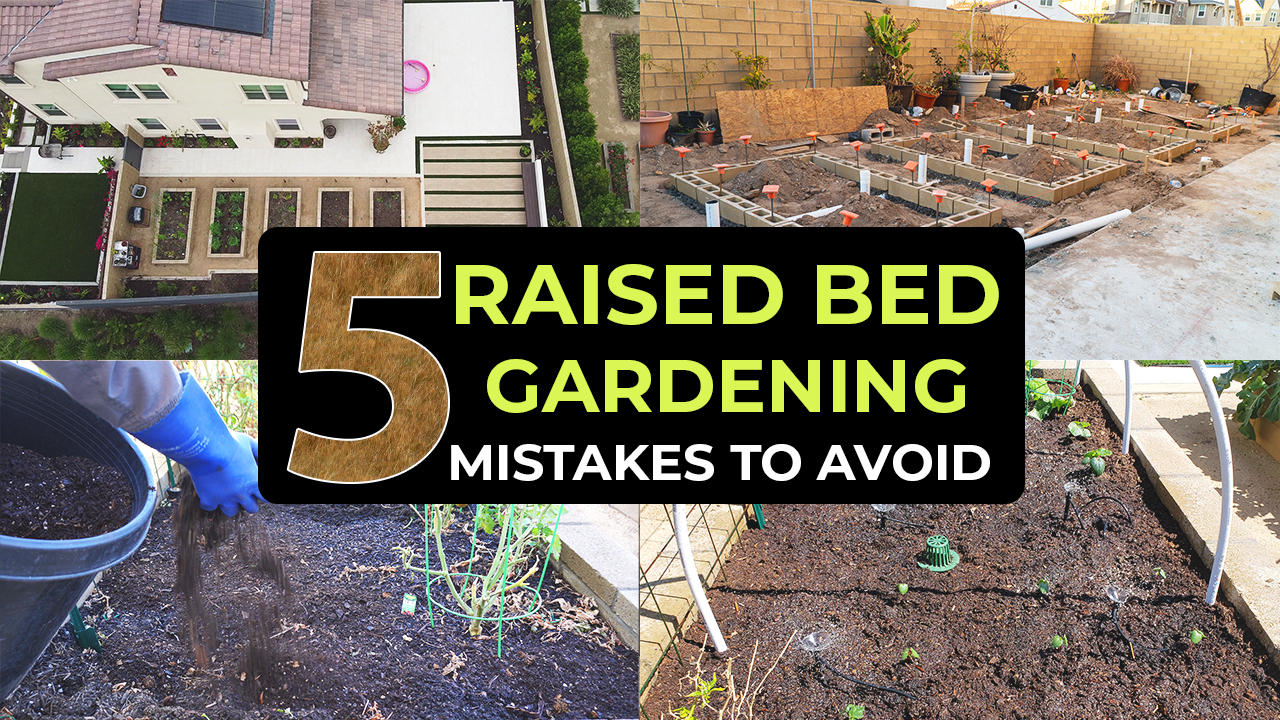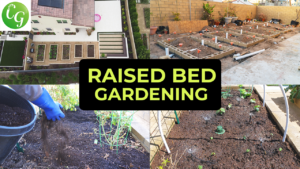
A great looking and productive raised bed garden is every gardener’s dream. In today’s video blog we look at 5 raised bed gardening mistakes that you can avoid to build your perfect raised bed garden.
- Not choosing the right material – Not choosing the right material for your raised bed can make or break your raised bed garden design. When we initially designed my raised bed garden, we chose cedar wood for the material. It can be easily assembled without the use of tools and cedar wood is natural wood that can withstand water, humidity and sunlight very well. These beds take up less space and it’s easy to attach drip irrigation or a trellis structure to the wooden material. However, these beds won’t last forever and you’ll end up replacing them every 5 years or so. So, for a more permanent alternative when we were replacing our raised beds, we went with a cement/cinder block. This setup requires a professional to layout the concrete and reinforce the structure with cement to make it sturdy. Overall, using concrete cinder blocks is my recommended choice for setting up a new raised bed garden.
- Not starting with good soil – Once your raised bed is set up, you need good quality soil to fill your raised beds, soil that retains moisture and nutrients. Good quality organic matter will help the plants uptake all the nutrients which results in healthier plants. Most organic fertilizers need soil microbes to break it down and make it available for the plants to uptake them. For our new raised beds, we had good quality black soil with organic amendments delivered to our home. This is a great mix of clay, sand and silt, with rich organic matter mixed in. We added this rich soil to start with, into our newly made raised beds and that gave us a great head start to our raised bed garden
- Using sprinklers instead of drip – The third raised bed gardening mistake is to use sprinklers over drip for watering your plants. Sprinklers do not provide adequate coverage and sometimes cause over watering and wastage in some areas while lack of water in other areas, especially once the plants grow taller. A good alternative to sprinklers is to use a low-pressure drip system, using the manifold
technique. The micro emitters do a great job of watering the entire raised bed area and can be easily controlled using a timer. There are many different ways of converting sprinklers to a drip irrigation system. We can use a riser connection kit, which connects to your existing drip irrigation system, along with 1/2” drip tubing to convert sprinklers to a drip irrigation system. You can use any kind of emitters like micro sprinklers or emitters that trickle a small stream or spray a wider stream, depending on the plants you have. Using drip conserves water and prevents wastage by directing it to just your raised bed area. Another technique is the manifold technique of drip irrigation conversion. We remove the sprinkler head from its position and attach the manifold with two or four outlets to the place where the sprinkler head was. We had 3 sprinkler heads per raised bed, so we used two with 4 outlets and one with 2 outlets, for a total of 10 drip emitter lines. Then we attach the quarter inch tubing onto the manifold outlets and attach drip emitters on the other end. The setup just takes a few minutes, and your raised bed will be watered much better than sprinklers, even after the plants grow taller, as the emitters are more spread out. - Not building your garden soil – Not building your raised bed garden soil is the other mistake that most gardeners make. Having a rich soil with organic matter should be a gardener’s goal at all times. Ignoring this is probably the biggest mistake that a lot of gardeners make. The easiest way to add organic material is to make your own compost. And if you can’t make your own compost, you can always buy bagged compost available at most garden stores. Compost can be spread around your garden bed and used as mulch or mixed into the soil. Another amendment which I highly recommend are adding worm castings, which add a lot of beneficial microbes to the soil which breakdown the soil and help the plants uptake the nutrients in the soil. Another way to build soil quality is to add beneficial bacteria via organic fertilizers. These organic fertilizers from AgroThrive have pre-digested nutrients that are readily available for plants. They also contain fermented fish by products, which contain valuable beneficial microbes. By adding organic fertilizers like AgroThrive, you are adding a gazillion beneficial bacteria in your soil. Adding such beneficial nutrients every 15 days or so will ensure your soil quality is optimum.
- Not using the correct trellising method – Not using the correct trellising method to support your plants is another common raised bed gardening mistake. For vines adding a trellis structure results in better support and greater yield. An easy trellis structure can be added between raised beds using a simple concrete re-mesh sheet that help support your plants. Other trellis methods include the EZ Trellis, that can be set up on the side of your raised bed and can be made as tall as you like. Using simple items like a concrete re-mesh sheet, rebars for support, EMT conduits for securing your trellis, and some 8-inch cable ties or zip ties, you can easily set up this EZ trellis in minutes. This adds a beautiful and sturdy trellis to your raised bed garden. We recently built a trellis to support our ivy gourd vines, we used two concrete re-mesh sheets that are held upright by two 5 ft fence posts. The re-mesh sheets are elevated to about 18 inches for a total trellis height of 6 feet. It looks elegant, is sturdy and is another great choice for setting up a trellis for your raised bed garden.
Watch our video at Top 5 Raised Bed Gardening Mistakes To Avoid – Garden in Raised Beds Effectively!


0 Comments